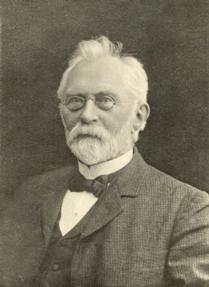
Eugen Warming (1841-1924)
On November 3, 1841, Danish botanist Eugen Warming was born. Warming is considered a main founding figure of the scientific discipline of ecology. He wrote the first textbook on plant ecology in 1895, taught the first university course in ecology and gave the concept its meaning and content.
Early Life and Education
Eugen Warming was born on the small Wadden Sea island of Mandø as the only child of Jens Warming, parish minister, and Anna Marie von Bülow af Plüskow. After the early death of his father, he moved with his mother to her brother in Vejle in eastern Jutland. Eugen Warming attended the University of Copenhagen. However, he left the university in order to work with the Danish palaeontologist Peter Wilhelm Lund, who worked in Lagoa Santa in Brazil, and travelled with this the tropical savannahs of Brazil. In 1867 he began studying botany at the University of Munich, from 1871 he studied microscopic methods with Johannes von Hanstein at the University of Bonn, where he completed his Doctorate degree in 1871 with a thesis on ontogeny of the cyathia of Euphorbia (Euphorbiaceae).
Academic Career
Eugen Warming became docent of botany at the University of Copenhagen, the polytechnic, and the Pharmaceutical College. In 1882 he was appointed professor of botany at Stockholms högskola.As the eldest professor, he was elected rector magnificus. In 1885 Warming was appointed professor of botany at the University of Copenhagen and director of the Copenhagen Botanical Garden. He held these positions until his retirement on 31 December 1910.
Research in Ecology
Warming’s early experience with vegetation in a tropical region was decisive for his future work. His collections from Lagoa Santa, 2600 plant species, of which some 370 turned out to be new to science, were treated in a monumental 40-volume and 1400-page work, Symbolæ ad Floram Brasiliæ centralis cognoscendam. For this work, Warming farmed out plant families to more than fifty plant taxonomists, mainly in Europe.
To Warming’s most important publications belongs his book Plantesamfund (Oecology of Plants, 1895), which was based on his lectures on plant geography at the University of Copenhagen and introduced all major biomes. His impact on the development of ecology was to explain how nature solved similar problems like drought, flooding, cold, salt or herbivory in similar way, despite using very different ‘raw material’ in different regions of the world. The translation of his textbook under the name Oecology of Plants has significantly influenced the further development of plant ecology in English-speaking countries.
“Certain species join together to form natural associations, i.e. associations which encounter us with the same composition of life forms and with the same appearance. Examples of plant associations are a meadow in Denmark or Northern Germany with all its grasses and perennials, or a beech forest on Zealand. Further: “The ecological plant geography should give an account of which natural associations occur, which household characterizes it and why species can be so closely connected with different households as is often the case. It must therefore be based on an understanding of the physical and, among other things, peculiarities of the sites”
— Eugen Warming, Plantesamfund (1895)
Despite the language barrier, Warming’s influence on the development of ecology is remarkable, not the least in Britain and the USA.
Teachings and Later Years
Eugen Warming became known as a great teacher, whose presentation of the subject was useful far beyond his lecture theatre in Copenhagen. In order to improve his teaching, Warming took his students to the botanical garden. However, to teach plant ecology, Warming figured that he needed his students to get out in nature. He applied for a grant to take students on longer excursions every year from 1893 and every third year these went to western Jutland, once to Bornholm, otherwise to Zealand. The excursion notes were published which included introductions to the environment and plant adaptation in dunes, salt marshes and other habitats.
Eugen Warming was a member of the Royal Danish Academy of Sciences and Letters. He further served on the board of directors of the Carlsberg Foundation and served on the board of the Geological Survey of Denmark. The Royal Swedish Academy of Sciences awarded him the Linné Medal in Gold in 1922. In 1914 he was elected to the American Academy of Arts and Sciences.
Eugen Warming died on 2 April 1924 at aged 82.
Jeff Gore, The Neutral Theory of Ecology, [7]
References and Further Reading:
- [1] Eugen Warming at Britannica Online
- [2] Eugen Warming at the Internet Archive
- [3] Works by or about Eugenius Warming at Internet Archive
- [4] Eugen Warming at Wikidata
- [5] Warming, Eugenius (1890) [1884]. Handbuch der systematischen Botanik [Haandbog i den systematiske botanik] (in German)
- [6] Tansley, A. G. (17 May 2017). “The Early History of Modern Plant Ecology in Britain”. Journal of Ecology. 35 (1/2): 130–137.
- [7] Jeff Gore, The Neutral Theory of Ecology, MIT 8.591J Systems Biology, Fall 2014, MIT OpenCourseWare @ youtube
- [8] Timeline of Eugen Warming via Wikidata






Pingback: Every Single Living Thing Is Part of an Ecosystem. Here’s How They Work – freelancecomli
Pingback: Every Single Living Thing Is Part of an http://knowledge-easy.com/wp-content/uploads/2019/10/ecosystem-1.html. Here’s How They Work – World Top Business Systems
Pingback: Что такое «экосистема»? | Дневник Эрудита